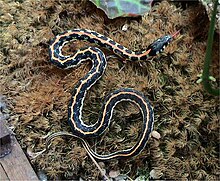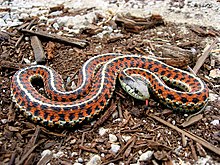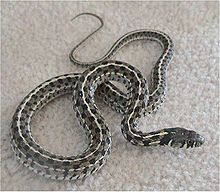Garter snake
| Garter snake | |
|---|---|

| |
| The eastern garter snake (Thamnophis sirtalis sirtalis) | |
| Scientific classification | |
| Kingdom: | Animalia |
| Phylum: | Chordata |
| Class: | Reptilia |
| Order: | Squamata |
| Suborder: | Serpentes |
| Family: | Colubridae |
| Subfamily: | Natricinae |
| Genus: | Thamnophis Fitzinger, 1843 |
| Species | |
|
35, see text | |

| |
| Thamnophis distribution | |
| Synonyms[1] | |
|
Atomarchus, Chilopoma, Eutaenia, Eutainia, Phamnovis, Prymnomiodon, Stypocemus, Tropidonote, Tropidonotus | |
Garter snake is a common name for generally harmless, small to medium-sized snakes belonging to the genus Thamnophis. Endemic to North and Central America, species in the genus Thamnophis can be found from the subarctic plains of Canada to Costa Rica.
Garter snakes vary in length from 46 to 137 cm (18 to 54 in) and weigh approximately 140 g (5 oz).[2] With no real consensus on the classification of species of Thamnophis, disagreement between taxonomists and sources such as field guides over whether two types of snakes are separate species or subspecies of the same species is common. Garter snakes are closely related to the genus Nerodia (water snakes), with some species having been moved back and forth between genera.
Taxonomy[]
The first garter snake to be identified was the eastern garter snake (now Thamnophis sirtalis sirtalis), by zoologist and taxonomist Carl Linnaeus in 1758. The genus Thamnophis was described by Leopold Fitzinger in 1843 as the genus for the garter snakes and ribbon snakes.[3] Many snakes previously identified as their own genera or species have been reclassified as species or subspecies in Thamnophis. There are currently 35 species in the genus, with several subspecies in some of them.[4]
Habitat[]
Garter snakes are present throughout most of North America. Their wide distribution is due to their varied diets and adaptability to different habitats, with varying proximity to water; however in the western part of North America these snakes are more aquatic than in the eastern portion. Garter snakes live in a variety of habitats, including forests, woodlands, fields, grasslands and lawns, but never far from water, often an adjacent wetland, stream or pond. This reflects the fact that amphibians are a large part of their diet. Garter snakes are often found near small ponds with tall weeds.
Behavior[]

Garter snakes have complex systems of pheromonal communication. They can find other snakes by following their pheromone-scented trails. Male and female skin pheromones are so different as to be immediately distinguishable. However, male garter snakes sometimes produce both male and female pheromones. During the mating season, this ability fools other males into attempting to mate with them. This causes the transfer of heat to them in kleptothermy, which is an advantage immediately after hibernation, allowing them to become more active.[5] Male snakes giving off both male and female pheromones have been shown to garner more copulations than normal males in the mating balls that form at the den when females enter the mating melee.
Garter snakes use the vomeronasal organ to communicate via pheromones through the tongue flicking behavior which gathers chemical cues in the environment. Upon entering the lumen of the organ, the chemical molecules will come into contact with the sensory cells which are attached to the neurosensory epithelium of the vomeronasal organ.[citation needed]
If disturbed a garter snake may coil and strike but typically it will hide its head and flail its tail. These snakes will also discharge a malodorous, musky-scented secretion from a gland near the cloaca. They often use these techniques to escape when ensnared by a predator. They will also slither into the water to escape a predator on land. Hawks, crows, egrets, herons, cranes, raccoons, otters and other snake species (such as coral snakes and kingsnakes) will eat garter snakes, with even shrews and frogs eating the juveniles.

Being heterothermic, like all reptiles, garter snakes bask in the sun to regulate their body temperature. During brumation (the reptile equivalent of hibernation) garter snakes typically occupy large communal sites called hibernacula. These snakes will migrate large distances to brumate.
Diet[]

Garter snakes, like all snakes, are carnivorous. Their diet consists of almost any creature they are capable of overpowering: slugs, earthworms (nightcrawlers, as red wigglers are toxic to garter snakes), leeches, lizards, amphibians (including frog eggs), minnows, and rodents. When living near water they will eat other aquatic animals. The ribbon snake (Thamnophis sauritus) in particular favors frogs (including tadpoles), readily eating them despite their strong chemical defenses. Food is swallowed whole. Garter snakes often adapt to eating whatever they can find and whenever they can find it because food can be either scarce or abundant. Although they feed mostly on live animals they will sometimes eat eggs.[6]
Venom[]
Garter snakes were long thought to be non-venomous but discoveries in the early 2000s revealed that they in fact produce a neurotoxic venom.[7] Despite this, garter snakes cannot seriously injure or kill humans with the small amounts of comparatively mild venom they produce and they also lack an effective means of delivering it. In a few cases some swelling and bruising have been reported.[8] They do have enlarged teeth in the back of their mouth[9] but their gums are significantly larger and the secretions of their Duvernoy's gland are only mildly toxic.[8][10]
Evidence suggests that garter snake and newt populations share an evolutionary link in their levels of tetrodotoxin resistance, implying co-evolution between predator and prey.[11] Garter snakes feeding on toxic newts can also retain those toxins in their liver for weeks, making those snakes poisonous as well as venomous.[12]
Conservation status[]


Despite the decline in their population from collection as pets (especially in the more northerly regions, in which large groups are collected at hibernation),[13] pollution of aquatic areas, and the introduction of American bullfrogs as potential predators, garter snakes are still some of the most commonly found reptiles in much of their ranges. The San Francisco garter snake (Thamnophis sirtalis tetrataenia), however, has been on the endangered list since 1969. Predation by crayfish has also been responsible for the decline of the narrow-headed garter snake (Thamnophis rufipunctatus).[14]
Species and subspecies[]


Arranged alphabetically by scientific name:
- Aquatic garter snake, T. atratus (Kennicott, 1860)
- , T. a. atratus (Kennicott, 1860)
- , T. a. hydrophilus Fitch, 1936
- , T. a. zaxanthus , 1999
- Bogert's garter snake, T. bogerti Rossman & , 2005
- Shorthead garter snake, T. brachystoma (Cope, 1892)
- Butler's garter snake, T. butleri (Cope, 1889)
- Goldenhead garter snake, T. chrysocephalus (Cope, 1885)
- Conant's garter snake, T. conanti Rossman & Burbrink, 2005
- Sierra garter snake, T. couchii (Kennicott, 1859)
- Blackneck garter snake, T. cyrtopsis (Kennicott, 1860)
- Western blackneck garter snake, T. c. cyrtopsis (Kennicott, 1860)
- Eastern blackneck garter snake, T. c. ocellatus (Cope, 1880)
- Tropical blackneck garter snake, T. c. collaris (Jan, 1863)

- Western terrestrial garter snake, T. elegans (Baird & Girard, 1853)
- Arizona garter snake, T. e. arizonae W. Tanner & Lowe, 1989
- Mountain garter snake, T. e. elegans (Baird & Girard, 1853)
- San Pedro Mártir garter snake, T. e. hueyi Van Denburgh & Slevin, 1923
- Coastal garter snake, T. e. terrestris Fox, 1951
- Wandering garter snake, T. e. vagrans (Baird & Girard, 1853)
- Upper Basin garter snake, T. e. vascotanneri W. Tanner & Lowe, 1989
- Mexican garter snake, T. eques (Reuss, 1834)
- Mexican garter snake, T. e. eques (Reuss, 1834)
- Laguna Totolcingo garter snake, T. e. carmenensis Conant, 2003
- T. e. cuitzeoensis Conant, 2003
- T. e. diluvialis Conant, 2003
- T. e. insperatus Conant, 2003
- Northern Mexican garter snake, T. e. megalops (Kennicott, 1860)
- T. e. obscurus Conant, 2003
- T. e. patzcuaroensis Conant, 2003
- T. e. scotti Conant, 2003
- T. e. virgatenuis Conant, 1963
- Mexican wandering garter snake, T. errans H. M. Smith, 1942

- Montane garter snake, T. exsul Rossman, 1969
- Highland garter snake, T. fulvus (Bocourt, 1893)
- Giant garter snake, T. gigas Fitch, 1940
- Godman's garter snake,[15] T. godmani (Günther, 1894)
- Two-striped garter snake, T. hammondii (Kennicott, 1860)
- Liner's garter snake, T. lineri Rossman & Burbrink, 2005[16]
- Checkered garter snake, T. marcianus (Baird & Girard, 1853)
- T. m. marcianus (Baird & Girard, 1853)
- T. m. praeocularis (Bocourt, 1892)
- T. m. bovalli (Dunn, 1940)
- Blackbelly garter snake, T. melanogaster
- , T. m. canescens H. M. Smith, 1942
- , T. m. chihuahuanensis W. Tanner, 1959
- , T. m. linearis H. M. Smith, & , 1950
- , T. m. melanogaster (W. Peters, 1864)

- Tamaulipan montane garter snake, T. mendax Walker, 1955
- Southern Durango spotted garter snake, T. nigronuchalis Thompson, 1957
- Northwestern garter snake, T. ordinoides (Baird & Girard, 1852)
- Tepalcatepec Valley garter snake, T. postremus Smith, 1942
- Western ribbon snake, T. proximus (Say, 1823)
- Chiapas Highlands ribbon snake, T. p. alpinus Rossman, 1963
- Arid land ribbon snake, T. p. diabolicus Rossman, 1963
- Gulf Coast ribbon snake, T. p. orarius Rossman, 1963
- Orangestripe ribbon snake or western ribbon snake T. p. proximus (Say, 1823)
- Redstripe ribbon snake, T. p. rubrilineatus Rossman, 1963
- Mexican ribbon snake, T. p. rutiloris (Cope, 1885)
- Yellow-throated garter snake, T. pulchrilatus (Cope, 1885)
- Plains garter snake, T. radix (Baird & Girard, 1853)
- Rossman's garter snake, T. rossmani Conant, 2000
- Narrow-headed garter snake, T. rufipunctatus (Cope, 1875)
- Ribbon snake, T. sauritus (Linnaeus, 1766)
- Bluestripe ribbon snake, T. s. nitae Rossman, 1963
- Southern ribbon snake, T. s. sackenii (Kennicott, 1859)
- Eastern ribbon snake, T. s. sauritus (Linnaeus, 1766)
- Northern ribbon snake, T. s. septentrionalis Rossman, 1963
- Longtail alpine garter snake, T. scalaris (Cope, 1861)
- Short-tail alpine garter snake, T. scaliger (Jan, 1863)
- Common garter snake, T. sirtalis
- Texas garter snake, T. s. annectens , 1950
 The Texas garter snake (Thamnophis sirtalis annectens)
The Texas garter snake (Thamnophis sirtalis annectens) - , T. s. concinnus (Hallowell, 1852)
- , T. s. dorsalis (Baird & Girard, 1853)
- , T. s. fitchi Fox, 1951
- California red-sided garter snake, T. s. infernalis (Blainville, 1835)
- T. s. lowei W. Tanner, 1988
- , T. s. pallidulus Allen, 1899
- Red-sided garter snake, T. s. parietalis (Say, 1823)
- Puget Sound garter snake, T. s. pickeringii (Baird & Girard, 1853)
- , T. s. similis Rossman, 1965
- Eastern garter snake, T. s. sirtalis (Linnaeus, 1758)
- Chicago garter snake, T. s. semifasciatus (Cope, 1892)
- San Francisco garter snake, T. s. tetrataenia (Cope, 1875)
- Texas garter snake, T. s. annectens , 1950
- Sumichrast's garter snake, T. sumichrasti (Cope, 1866)
- , T. unilabialis W. Tanner, 1985
- West Coast garter snake, T. validus
- , T. v. celaeno (Cope, 1860)
- T. v. isabellae (Conant, 1953)
- T. v. thamnophisoides (Conant, 1961)
- T. v. validus (Kennicott, 1860)
In the above list, a binomial authority or a trinomial authority in parentheses indicates that the species or subspecies was originally described in a genus other than Thamnophis.
See also[]
- Narcisse Snake Dens
- List of snakes, overview of all snake families and genera
References[]
- ^ Wright AH, Wright AA (1957). Handbook of Snakes of the United States and Canada. Ithaca and London: Comstock Publishing Associates, a division of Cornell University Press. 1,105 pp. (in 2 volumes). (Thamnophis, p. 755).
- ^ "BioKIDS - Kids' Inquiry of Diverse Species, Thamnophis sirtalis, Common Garter Snake: INFORMATION". www.biokids.umich.edu. Retrieved 2019-07-18.
- ^ "ITIS Standard Report Page: Thamnophis". www.itis.gov. Retrieved 2019-07-06.
- ^ "The IUCN Red List of Threatened Species". IUCN Red List of Threatened Species. Retrieved 2019-07-06.
- ^ Shine, R; Phillips, B; Waye, H; LeMaster, M; Mason, RT (2001). "Benefits of female mimicry to snakes". Nature. 414 (6861): 267. Bibcode:2001Natur.414..267S. doi:10.1038/35104687. PMID 11713516. S2CID 205023381.
- ^ "Garter Snake Care Sheet". Thamnophis.com.
- ^ Zimmer, Carl (April 5, 2005). "Open Wide: Decoding the Secrets of Venom". The New York Times.
- ^ Jump up to: a b Smith, Michael (September 2001). "Duverney's Glands and "Warm" Herping". Cross Timbers Herpetologist. Dallas-Fort Worth Herpetological Society – via Melissa Kaplan's Herp Care Collection.
- ^ Wright, Debra L.; Kardong, Kenneth V.; Bentley, David L. (1979). "The Functional Anatomy of the Teeth of the Western Terrestrial Garter Snake, Thamnophis elegans". Herpetologica. 35 (3): 223–228. JSTOR 3891690.
- ^ de Queiroz, Alan (September 27, 2010). "Garter Snakes". Online Nevada Encyclopedia. Nevada Humanities. Retrieved December 29, 2016.
- ^ Williams, Becky L.; Brodie, Edmund D. Jr.; Brodie, Edmund D. III (2003). "Coevolution of Deadly Toxins and Predator Resistance: Self-Assessment of Resistance by Garter Snakes Leads to Behavioral Rejection of Toxic Newt Prey". Herpetologica. 59 (2): 155–163. doi:10.1655/0018-0831(2003)059[0155:codtap]2.0.co;2.
- ^ Williams, Becky L.; Brodie, Edmund D. Jr.; Brodie, Edmund D. III (2004). "A resistant predator and its toxic prey: persistence of newt toxin leads to poisonous (not venomous) snakes". Journal of Chemical Ecology. 30 (10): 1901–1919. doi:10.1023/B:JOEC.0000045585.77875.09. PMID 15609827. S2CID 14274035.
- ^ Zimmerman R (2013). "Thamnophis sirtalis ". Kids' Inquiry of Diverse Species. Animal Diversity Web. Retrieved November 5, 2016.
- ^ Hammerson GA (2007). "Thamnophis rufipunctatus ". IUCN Red List of Threatened Species. 2007: e.T63990A12727179. doi:10.2305/IUCN.UK.2007.RLTS.T63990A12727179.en.
- ^ Beolens, Bo; Watkins, Michael; Grayson, Michael (2011). The Eponym Dictionary of Reptiles. Baltimore: Johns Hopkins University Press. xiii + 296 pp. ISBN 978-1-4214-0135-5. (Thamnophis godmani, p. 102).
- ^ Thamnophis lineri. The Reptile Database. www.reptile-database.org.
External links[]
- González-Fernández, Andrea; Manjarrez, Javier; García-Vázquez, Uri; D'Addario, Maristella; Sunny, Armando (2018). "Present and future ecological niche modeling of garter snake species from the Trans-Mexican Volcanic Belt". PeerJ. 6: e4618. doi:10.7717/peerj.4618. PMC 5903425. PMID 29666767.
| Wikimedia Commons has media related to: Thamnophis (category) |
| Wikisource has the text of the 1906 New International Encyclopedia article "Garter-snake". |
- Anapsid.org: Garter snakes
- Several pictures of a Mexican ribbon snake (Thamnophis proximus rutiloris)
- Plains garter snake - Thamnophis radix. Species account from the Iowa Reptile and Amphibian Field Guide
- Eastern garter snake - Thamnophis sirtalis. Species account from the Iowa Reptile and Amphibian Field Guide
- Descriptions and biology of garter snakes
- Genus Thamnophis at The Reptile Database
Further reading[]
- Conant R (1975). A Field Guide to Reptiles and Amphibians of Eastern and Central North America, Second Edition. Boston: Houghton Mifflin Company. xviii + 429 pp. + Plates 1-48. ISBN 0-395-19979-4 (hardcover), ISBN 0-395-19977-8 (paperback). (Genus Thamnophis, p. 157).
- Fitzinger L (1843). Systema Reptilium, Fasciculus Primus, Amblyglossae. Vienna: Braumüller & Seidel. 106 pp. + indices. (Thamnophis, new genus, p. 26). (in Latin).
- Goin, Coleman J., Goin, Olive B.; Zug, George R. (1978). Introduction to Herpetology, Third Edition. San Francisco: W.H. Freeman and Company. xi + 378 pp. ISBN 0-7167-0020-4. (Thamnophis, pp. 132, 156, 326).
- Powell R, Conant R, Collins JT (2016). Peterson Field Guide to Reptiles and Amphibians of Eastern and Central North America, Fourth Edition. Boston and New York: Houghton Mifflin Harcourt. xiv + 494 pp., 47 plates, 207 figures. ISBN 978-0-544-12997-9. (Genus Thamnophis, p. 426).
- Ruthven AG (1908). "Variation and Genetic Relationships of the Garter-snakes". Bull. U. S. Nat. Mus. 61: 1–201, 82 figures.
- Schmidt, Karl P.; Davis, D. Dwight (1941). Field Book of Snakes of the United States and Canada. New York: G.P. Putnam's Sons. 365 pp., 34 plates, 103 figures. (Genus Thamnophis, p. 236).
- Stebbins RC (2003). A Field Guide to Western Reptiles and Amphibians, Third Edition. The Peterson Field Guide Series . Boston and New York: Houghton Mifflin Company. xiii + 533 pp., 56 plates. ISBN 978-0-395-98272-3. (Genus Thamnophis, pp. 373–374).
- Vandenburgh J, Slevin JR (1918). "The Garter-snakes of Western North America". Proc. California Acad. Sci., Fourth Series 8: 181–270, 11 plates.
- Thamnophis
- Reptiles of Canada
- Reptiles of the United States
- Reptiles of Mexico
- Snakes of Central America
- Extant Miocene first appearances
- Taxa named by Leopold Fitzinger
- Snake common names
